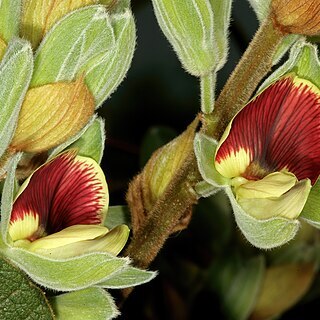Robust creeper or climber 2-8 m long, the main stems attaining 8 mm in diameter. Stems covered with dense short ferruginous hairs, later glabrescent. Leaflets 3, often pale beneath, the terminal one 4.8-18(20) x 3.8-14(17.5) cm, elliptic, circular, ovate or rhombic, the laterals 4-13 x 2.5-9 cm, obliquely ovate, all acuminate, rounded to slightly subcordate at the base, sparsely pubescent to glabrescent above, pubescent to thickly grey-velvety, more rarely rusty-velvety beneath with the veins accentuated with ferruginous hairs; petiole 7-10(14) cm long; rhachis 2-4 cm long; petiolules 3-6 mm long; stipules 1.2-1.4 cm long, elliptic-lanceolate. Inflorescences sometimes branched; rhachis 7-35 cm long; peduncles 2-9 cm long, ferruginous pubescent to velvety hairy; pedicels 0.7-1.8 cm long; bracts (1)1.2-1.8 x (0.6)1-1.6 cm, broadly elliptic or rarely lanceolate, acuminate, velvety ferruginous pubescent. Calyx appressed greyish pubescent with some ferruginous hairs at the base or entirely rusty-hairy; tube 5-6 mm long; lobes usually unequal, oblong-elliptic, the lowest 1.4-2.3 cm long, the laterals 0.9-1.7 cm long, the upper pair joined almost to the apex to form a prominently bifid lip. Corolla persistent, mostly shorter than the calyx, greenish-cream to orange or pink with red or purple veining and flush, later brick-red; standard 1.8-2.2 x 1.25-1.8 cm, almost circular save for the claw, slightly emarginate, glabrous. Pods twisted, 1.5-3 cm x 3.5-7 mm, narrowly oblong, velvety pubescent. Seeds blue when fresh, later black, remaining attached to the pod, 5-6.5 x 3.5-4.5 mm, depressed-globular.
A robust creeper. It grows 5 m high. The main stems can be 8 mm across. The stems have dense rusty hairs. The leaves have 3 leaflets. These are often pale underneath. The end leaflet is 5-18 cm long by 4-14 cm wide. The side leaflets are 4-13 cm long by 3-9 cm wide. They taper to the tips. The flowering stalks can be branched and they have velvety rusty hairs. The flowers are yellow. The fruit are twisted pods 2-3 cm long by 4-7 mm wide. They are narrowly oblong. They have velvety hairs. The seeds are blue.
Leaflets 3, often pale beneath, the terminal one 4.8–18(20) × 3.8–14(17.5) cm, elliptic, circular, ovate or rhombic, the laterals 4–13 × 2.5–9 cm, obliquely ovate, all acuminate, rounded to slightly subcordate at the base, sparsely pubescent to glabrescent above, pubescent to thickly grey-velvety, more rarely rusty-velvety beneath with the veins accentuated with ferruginous hairs; petiole 7–10(14) cm long; rhachis 2–4 cm long; petiolules 3–6 mm long; stipules 1.2–1.4 cm long, elliptic-lanceolate.
Calyx appressed greyish pubescent with some ferruginous hairs at the base or entirely rusty-hairy; tube 5–6 mm long; lobes usually unequal, oblong-elliptic, the lowest 1.4–2.3 cm long, the laterals 0.9–1.7 cm long, the upper pair joined almost to the apex to form a prominently bifid lip.
Inflorescences sometimes branched; rhachis 7–35 cm long; peduncles 2–9 cm long, ferruginous pubescent to velvety hairy; pedicels 0.7–1.8 cm long; bracts (1)1.2–1.8 × (0.6)1–1.6 cm, broadly elliptic or rarely lanceolate, acuminate, velvety ferruginous pubescent.
Corolla persistent, mostly shorter than the calyx, greenish-cream to orange or pink with red or purple veining and flush, later brick-red; standard 1.8–2.2 × 1.25–1.8 cm, almost circular save for the claw, slightly emarginate, glabrous.
Seeds blue when fresh, later black, remaining attached to the pod, 5–6.5 × 3.5–4.5 mm, depressed-globular.
Robust creeper or climber 2–8 m long, the main stems attaining 8 mm in diameter.
Pods twisted, 1.5–3 cm × 3.5–7 mm, narrowly oblong, velvety pubescent.
Stems covered with dense short ferruginous hairs, later glabrescent.

